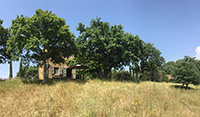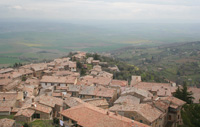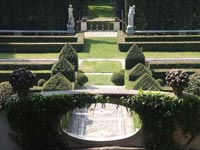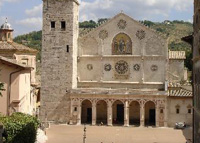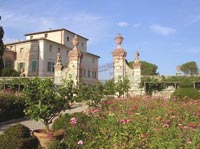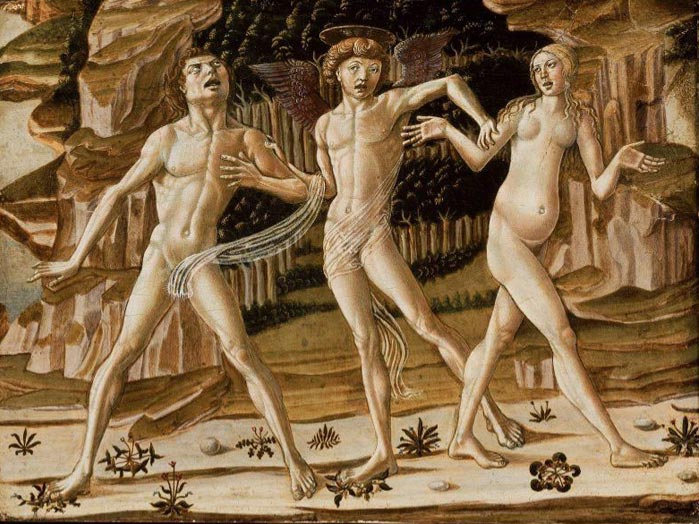 |
Benvenuto di Giovanni, Expulsion from Paradise, 1470s, Museum of Fine Arts, Boston |
| Benvenuto di Giovanni (1436 - before 1517) |
| Benvenuto di Giovanni di Meo del Guasta is first documented as a young painter in 1453, when he worked alongside Vecchietta, who was probably his teacher, on the fresco decoration of the baptistry of Siena. In that same year he painted a now-lost work in the chapter house of the Compagnia di Santa Lucia in Siena. Benvenuto is mentioned again in 1460, along with Vecchietta and Francesco di Giorgio, as being in the debt of Siena's Opera del Duomo; around this date he must have painted the baptistry fresco series of stories from the life of Saint Anthony of Padua as well as a panel, The Miracle of Saint Anthony (Munich, Alte Pinakothek), which according to a recent proposal was probably part of a lost predella with scenes painted by Vecchietta and Francesco di Giorgio.[1]
The first dated work by Benvenuto to come down to us is an Annunciation and Saints (1466) in the church of San Girolamo in Volterra, for which the artist also painted a Nativity (1470) and a predella with stories of the life of Christ, now in the Volterra Pinacoteca. Also of 1470 is the Annunciation panel in the church of San Bernardino in Sinalunga. During this period Benvenuto's artistic idiom, which in his earliest phases clearly shows the influence of Vecchietta and the naturalistic vision of Domenico di Bartolo, acquires its individualism. This is due in part to his prolonged contact with two North Italian miniaturists who were active in Siena, Liberale da Verona and Girolamo da Cremona. Under their influence Benvenuto's noble, classical forms congeal to a hard, intensely lit, brightly colored, and glassy consistency, inserted into solidly balanced compositional structures. Masterpieces from this sharply defined, immaculately surreal world are the triptych from Montepertuso (dated 1475, now in the parish church of Vescovado di Murlo, near Siena), the Borghesi altarpiece in the church of San Domenico in Siena (1475-1477/1478), and the triptych in the National Gallery, London (1479). In the 1480s Benvenuto was commissioned to prepare designs for the floor decoration of the Siena cathedral and miniatures for its choir books (now in the Libreria Piccolomini) and for those of the monastery of Sant'Eugenio near Siena (now in the library of the abbey of Cava dei Tirreni). For Sant'Eugenio he also realized the large Ascension of Christ altarpiece, signed and dated 1491 (now in the Pinacoteca Nazionale in Siena; the predella panels are at the NGA), a work in which his severely classical language, charged with a latent expressive passion derived from northern painting, achieved its most intense results. In the following years his works show a simpler, more schematic compositional structure and more pleasant, sometimes sugary expressions, in part because of increasingly frequent collaboration with his son, Girolamo di Benvenuto. Nonetheless, despite the identical composition of two large panels of the Assumption of the Virgin pictures, both of 1498 (one formerly no. 10.148 in the Metropolitan Museum of Art, New York, signed by Benvenuto, and the other in the Museo d Arte Sacra in Montalcino, signed by his son) the styles of the two artists are clearly distinguishable. At the beginning of the sixteenth century the older master's works reveal incrementally the exhaustion of his creative imagination and a recourse to tried and true formulas from the past, as in the case of his last signed work, the Madonna and Child with Saints in the church of Santa Lucia in Sinalunga, dated 1509. [This is the artist's biography published, or to be published, in the NGA Systematic Catalogue] |
The Meeting of Jephthah and his Daughter The painting, probably part of the furnishing of a domestic interior, shows Jephthah daughter and her maidens stepping forward to welcome him on his arrival. Jephthah, on a black horse, clutches his breast in despair. The soldiers wave olive branches to symbolize the peace that will follow their victory. The attribution to Benvenuto di Giovanni is debated, various other artists including Pietro di Domenico, Francesco di Giorgio and Girolamo di Benvenuto were also suggested.
|
|
|
Lamentation Benvenuto di Giovanni about 1490 Tempera and gold on panel, 53 x 102 cm (without the painted surround: 35 x 80 cm) Poliarco S.A. |
||
| The Annunciation, influenced by Matteo di Giovanni, is characterised by the clear atmosphere in which characters, vistas and objects such as those appearing in the open wardrobe are depicted with a rigorous perspective | The Annunciation tempera on panel 250.5x177 cm (1470) Sinalunga - Chiesa di San Bernardino |
|
| Many Italian cities celebrated the feast of Epiphany with elaborate pageants that reenacted the procession of the Three Magi. This panel, a maze of pattern and rich decoration, captures the splendor of these spectacles. Costly brocades and furs adorn the three kings. A page on the right wears a peacock-feather cap; even his horse has an elaborately coiffed mane. Crowns and sword hilts are raised in plaster relief and gilded. The figures crowd the front of the picture plane, but we are separated from the holy figures rather than drawn into their world. The central placement of the Virgin—rather than the Magi—reflects her importance in Siena.
The harsh colors and brittle hardness convey a sensation of an airless, crystalline world. The ground is strewn with smooth, vividly colored stones; probably these jewel-toned beads are borrowed from manuscript illuminations. Benvenuto punctuated his scene with fantasy—look, for example, at the soldier's armor in the scene of Christ carrying the cross. Also typical is his inclusion of such everyday details as the young boys who have climbed a tree for a better view. |
Benvenuto di Giovanni The Adoration of the Magi, c. 1470/1475 Andrew W. Mellon Collection |
|
The Agony in the Garden, probably 1491 tempera on panel painted surface: 42 x 46.7 cm (16 9/16 x 18 3/8 in.) overall: 43.3 x 48 cm (17 1/16 x 18 7/8 in.) framed: 59.7 x 283.2 x 5.4 cm (23 1/2 x 111 1/2 x 2 1/8 in.) Samuel H. Kress Collection |
||
Christ Carrying the Cross, probably 1491 tempera on panel painted surface: 41.4 x 47.4 cm (16 5/16 x 18 11/16 in.) overall size: 42.8 x 50.1 cm (16 7/8 x 19 3/4 in.) framed (with three other paintings): 59.7 x 283.2 x 5.4 cm (23 1/2 x 111 1/2 x 2 1/8 in.) Samuel H. Kress Collection |
||
Christ in Limbo, probably 1491 tempera on panel painted surface: 42.1 x 46.6 cm (16 9/16 x 18 3/8 in.) overall size: 43 x 48.7 cm (16 15/16 x 19 3/16 in.) framed (with three other paintings): 59.7 x 283.2 x 5.4 cm (23 1/2 x 111 1/2 x 2 1/8 in.) Samuel H. Kress Collection |
||
The Crucifixion, probably 1491 tempera on panel painted surface: 41.2 x 52.9 cm (16 1/4 x 20 13/16 in.) overall size: 42.6 x 53.8 cm (16 3/4 x 21 3/16 in.) framed (with three other paintings): 59.7 x 283.2 x 5.4 cm (23 1/2 x 111 1/2 x 2 1/8 in.) Samuel H. Kress Collection |
||
Madonna and Child with Saint Jerome and Saint Bernardino of Siena, c. 1480/1485 tempera on panel overall: 70.3 x 50 cm (27 11/16 x 19 11/16 in.) Widener Collection |
||
The Resurrection, probably 1491 tempera on panel painted surface: 42.1 x 47.4 cm (16 9/16 x 18 11/16 in.) overall size: 43.5 x 49.7 cm (17 1/8 x 19 9/16 in.) framed (with three other paintings): 59.7 x 283.2 x 5.4 cm (23 1/2 x 111 1/2 x 2 1/8 in.) Samuel H. Kress Collection |
||
| On the cover of the ledger of the Gabella is celebrated the allegory of the good virtues; here the integrity of the public officials represents the foundation of the good government. Art in Tuscany | Sienese Biccherna Covers | Biccherne Senesi |
|
|
 |
||
Benvenuto di Giovanni, The Triumph of David, (ca. 1459-60 ), Siena, Pinacoteca Nazionale |
||
| The panel, from the vestry of the church of San Francesco in Siena, was originally the front part of a nuptial chest executed for the wedding of two members of the Buonsignori and Piccolomini families as shown by the two coats of arms. It represents a nuptial theme: David, after having killed Goliath, getting on a triumphal chariot in Jerusalem to marry the daughter of the king, Michal.
Art in Tuscany | Italian Renaissance Cassoni paintings
|
||
|
|
||||
|
||||
Podere Santa Pia |
Podere Santa Pia, giardino |
Podere Santa Pia |
||
Siena, duomo |
Montalcino |
Florence, Duomo |
||
Villa I Tatti |
Spoleto |
|||
| Medieval hill top towns of Val d'Orcia | Traveling along the via Cassia |
||||
| Gently undulating hillside and lush green valleys traversed by the Orcia river and the ancient via Cassia. This is the Val d'Orcia, a place where to admire both the enchanting landscapes and the picturesque towns of the Tuscan countryside. Following the Via Francigena, this itinerary commences in Montalcino, town where the Brunello di Montalcino, one of Italy's most famous wines, is produced. Positioned on the summit of a hill, Montalcino is an ancient town which jealously guards both its artworks and its history. The imposing Rocca di Montalcino, occupying a strategic position overlooking all potential access points, defended the town from attack for centuries. Amidst the narrow roads of the historic center, important works of architecture can be seen. The Church of Sant Egidio and the Church of Sant'Agostino were both built in the 14th century, whilst the cathedral, constructed on the site of an ancient 9th century house of worship, dates back to the neoclassical period. Another masterpiece of religious architecture, the Abbey of Sant Antimo, is situated just a few kilometers from Montalcino. Legend has it that this splendid example of Tuscan Romanesque was built on the site of the votive chapel erected by Charlemagne so as to conserve the relics of Saint Sebastian and Saint Antimo. Like Montalcino, nearby San Quirico d'Orcia is of ancient origin. The town's historic center, enclosed within sturdy perimeter walls, boasts some fourteen medieval towers. Although the foundation of San Quirico dates back to the time of the Etruscans, it was in the middle ages and the renaissance that the town's most important edifices were erected. The Collegiate Church of Saints Quirico and Giulitta was built in the Romanesque period, some three centuries or so before the town's Horti Leonini were constructed. The Horti Leonini provide a unique example of renaissance style Italian gardens, created on terrain given to Diomede Leoni as a gift by Francesco I dei Medici in 1581. Whilst San Quirico d'Orcia is known for its gardens, Bagno Vignoni is famous for the 16th century baths lying at its center and filled with thermal water which arrives at a temperature of 50° directly from the tiny little town's volcanic springs. Known since Roman times, the health inducing properties of Bagno Vignoni's water were apparently much appreciated by none other than Santa Caterina of Siena, to whom the small sanctuary situated directly opposite the baths is dedicated. The symbol of Castiglione d'Orcia is, without doubt, its impressive Rocca degli Aldobrandeschi, stronghold situated in the highest point of the town, and from where a spectacular view of the entire valley can be admired. Castiglione d'Orcia was the birthplace of Lorenzo di Pietro, painter better known by the name of Vecchietta and after whom the town's main square, with unusual cobbled paving and geometric designs, has been named. This itinerary draws to a close in Pienza, the Ideal Renaissance City. When the town's most illustrious citizen, Enea Silvio Piccolomini, became Pope Pius II, he ensured that his birthplace got a serious face-lift, which would respect, to the letter, the canons of renaissance aesthetics. The experiment was a resounding success, and resulted in a stunning trapezoidal piazza, a cathedral by Bernardo Rossellino, and the elegant Palazzo Borgia and Palazzo Piccolomini. Renaissance perfection aside, a trip to Pienza offers visitors the opportunity to stock up on the town's world famous Pecorino cheese, to taste and purchase in the various delicatessens lining the streets of the historic center. Without doubt Montepulciano has to be one of the most beautiful Medieval towns of Tuscany, resting at 600 meters above sea level protected by still impressively intact walls. Montepulciano is known for its noble Renaissance town houses and for the elegant architecture of its churches. Among the many monuments to be admired: Palazzo Budelli, Palazzo Comunale, the Temple of the Madonna of St Biagio and the Church of St Agostino. All of the buildings are of great artistic significance and are linked to Michelozzo, Antonio da Sangallo and Pietro Budelli. Montepulciano is also known for its fine wine, the Vino Nobile, much acclaimed internationally, and produced in the surrounding countryside. It is the home to many traditional events such as the summer Cantiere Internazionale d'Arte, the Bruscello, and the Bravio with period costumes and tournaments which evoke the history of Montepulciano. |
||||


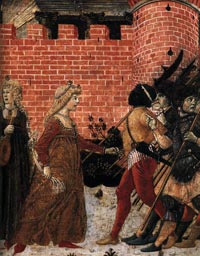
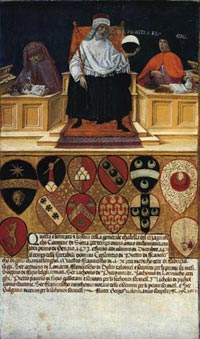 Benvenuto di Giovanni
Benvenuto di Giovanni

